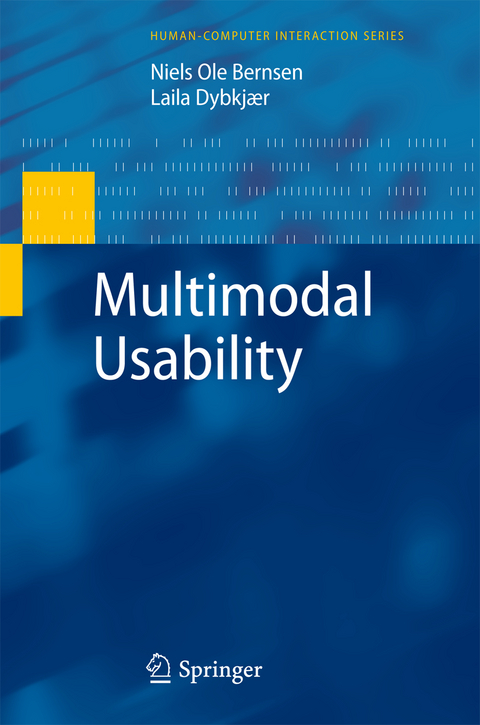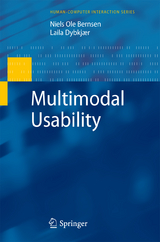Multimodal Usability
Seiten
2009
Springer London Ltd (Verlag)
978-1-84882-552-9 (ISBN)
Springer London Ltd (Verlag)
978-1-84882-552-9 (ISBN)
This book details what system developers need to know and need to be able to do in order to develop usable new multimodal applications. It covers the theory of modalities and multimodality and presents nine key multimodal usability parameters.
This preface tells the story of how Multimodal Usability responds to a special challenge. Chapter 1 describes the goals and structure of this book. The idea of describing how to make multimodal computer systems usable arose in the European Network of Excellence SIMILAR – “Taskforce for cre- ing human-machine interfaces SIMILAR to human-human communication”, 2003– 2007, www. similar. cc. SIMILAR brought together people from multimodal signal processing and usability with the aim of creating enabling technologies for new kinds of multimodal systems and demonstrating results in research prototypes. Most of our colleagues in the network were, in fact, busy extracting features and guring out how to demonstrate progress in working interactive systems, while claiming not to have too much of a notion of usability in system development and evaluation. It was proposed that the authors support the usability of the many multimodal pro- types underway by researching and presenting a methodology for building usable multimodal systems. We accepted the challenge, rst and foremost, no doubt, because the formidable team spirit in SIMILAR could make people accept outrageous things. Second, h- ing worked for nearly two decades on making multimodal systems usable, we were curious – curious at the opportunity to try to understand what happens to traditional usability work, that is, work in human–computer interaction centred around tra- tional graphical user interfaces (GUIs), when systems become as multimodal and as advanced in other ways as those we build in research today.
This preface tells the story of how Multimodal Usability responds to a special challenge. Chapter 1 describes the goals and structure of this book. The idea of describing how to make multimodal computer systems usable arose in the European Network of Excellence SIMILAR – “Taskforce for cre- ing human-machine interfaces SIMILAR to human-human communication”, 2003– 2007, www. similar. cc. SIMILAR brought together people from multimodal signal processing and usability with the aim of creating enabling technologies for new kinds of multimodal systems and demonstrating results in research prototypes. Most of our colleagues in the network were, in fact, busy extracting features and guring out how to demonstrate progress in working interactive systems, while claiming not to have too much of a notion of usability in system development and evaluation. It was proposed that the authors support the usability of the many multimodal pro- types underway by researching and presenting a methodology for building usable multimodal systems. We accepted the challenge, rst and foremost, no doubt, because the formidable team spirit in SIMILAR could make people accept outrageous things. Second, h- ing worked for nearly two decades on making multimodal systems usable, we were curious – curious at the opportunity to try to understand what happens to traditional usability work, that is, work in human–computer interaction centred around tra- tional graphical user interfaces (GUIs), when systems become as multimodal and as advanced in other ways as those we build in research today.
Structure, Usability, Readership.- Intermezzo 1: Three Multimodal Cases.- Creating a Model of Use.- Modalities and Devices.- Intermezzo 2: Status on Cases and Next Steps.- Common Approaches, Methods, Planning.- Intermezzo 3: Case Usability Workplan, Design.- Question-Answering.- Meetings with Discussion.- Observation of Users.- Imagination.- Interaction with the System.- Lab Sessions with Subjects.- Intermezzo 4: Case Usability Method Plan.- Data Handling.- Usability Data Analysis and Evaluation.- Intermezzo 5: Sudoku Usability Evaluation.- Multimodal Usability: Conclusions and Future Work.
| Erscheint lt. Verlag | 19.10.2009 |
|---|---|
| Reihe/Serie | Human–Computer Interaction Series |
| Zusatzinfo | 88 Illustrations, black and white; XVI, 431 p. 88 illus. |
| Verlagsort | England |
| Sprache | englisch |
| Maße | 155 x 235 mm |
| Themenwelt | Mathematik / Informatik ► Informatik ► Betriebssysteme / Server |
| Mathematik / Informatik ► Informatik ► Grafik / Design | |
| Informatik ► Software Entwicklung ► User Interfaces (HCI) | |
| Mathematik / Informatik ► Informatik ► Theorie / Studium | |
| ISBN-10 | 1-84882-552-8 / 1848825528 |
| ISBN-13 | 978-1-84882-552-9 / 9781848825529 |
| Zustand | Neuware |
| Haben Sie eine Frage zum Produkt? |
Mehr entdecken
aus dem Bereich
aus dem Bereich
Aus- und Weiterbildung nach iSAQB-Standard zum Certified Professional …
Buch | Hardcover (2023)
dpunkt Verlag
34,90 €
Lean UX und Design Thinking: Teambasierte Entwicklung …
Buch | Hardcover (2022)
dpunkt (Verlag)
34,90 €
Wissensverarbeitung - Neuronale Netze
Buch | Hardcover (2023)
Carl Hanser (Verlag)
34,99 €




